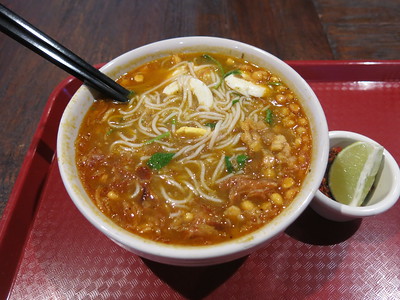
Unless you’re a bit of a foodie there is a reasonably good chance you won’t have heard of mohinga. Well, for your information, as a rival to laphet thoke, it is considered by many Burmese to be the national dish. Once a traditional breakfast staple, the spicy fish noodle soup is now more thought of as a snack that can be eaten anytime. The tasty soup is available at restaurants, cafes, roadside stalls and street vendors, in towns and cities throughout the country.

Typical Burmese mohinga street vendor. Photo credit: Wikimedia/CC BY-SA 3.0
Mohinga is typical of Burmese cooking in as much as it is a subtle blend of sweet, sour, salty, and spicy flavours. Since there are no formal written recipes for the aromatic soup from pre-colonial times it is thought that it most likely originated as a commoner’s meal. The earliest known reference to Mohinga itself was made in verse by the famous 19th-century Burmese playwright U Ponnya.
The essential ingredients of an authentic mohinga are freshwater catfish and fermented vermicelli rice noodles. However, the catfish is sometimes substituted by other types of fish such as mrigal carp. Other ingredients of the rich soup dish can vary somewhat since there are almost twenty recognised regional variations. However, most versions include gram flour and/or rice flour, garlic, onion, ginger, lemongrass, turmeric, and fish paste.
Garnishes for the tasty soup include (but are not limited to) the likes of chickpea fritters, lime juice, boiled eggs, shallots, fish sauce, spring onions, coriander and chilli flakes. In Myanmar, mohinga is almost always eaten with ‘mohinga zun’, known in the West as Chinese soup spoons.
Why not check out this easy-to-follow mohinga recipe on YouTube:
Header photo credit: Flickr/CC BY 2.0





